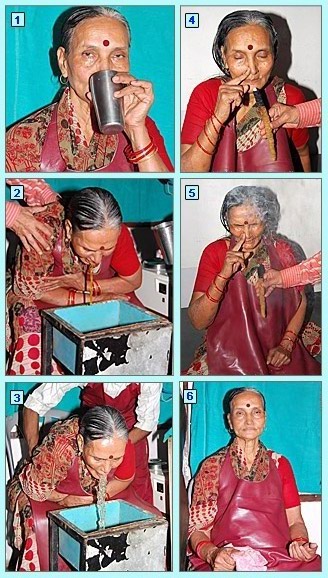 Preparation for vamana in Ayurveda usually takes a few days. Snehana and swedana is administered for seven consecutive days in order to prepare for vamana. After oleation and heating, the patient should show the signs of complete internal and external oleation. Ayurvedic physician, while administering these procedures always looks for a shiny, slightly oily and soft quality to the patient`s skin. When the dhatus get fully lubricated, the excess oil and ghee become clearly evident through the oily smell emanating from the body and the faeces. At this stage, the patient is considered ready and vamana can be planned for early in the next morning during the kapha period.
Preparation for vamana in Ayurveda usually takes a few days. Snehana and swedana is administered for seven consecutive days in order to prepare for vamana. After oleation and heating, the patient should show the signs of complete internal and external oleation. Ayurvedic physician, while administering these procedures always looks for a shiny, slightly oily and soft quality to the patient`s skin. When the dhatus get fully lubricated, the excess oil and ghee become clearly evident through the oily smell emanating from the body and the faeces. At this stage, the patient is considered ready and vamana can be planned for early in the next morning during the kapha period.
One night before the procedure of vamana is administered; the patient takes those food items that fuel kapha. For instance, sweet, sticky, heavy, cool and oily foods like black lentil soup, bananas, yogurt and milk are the most preferred options. These food items increase the volume in the stomach and it provides the impetus for kapha associated toxins to be expelled as because the stomach cannot hold the increased quantity. Just before the patient retires to bed, an herb is given that stimulates stomach secretions which further increase the volume of its contents. This particular herb is called vacha and it has been used in Ayurveda for this particular purpose for thousands of years. The energy of this herb is hot that causes the aama in the stomach to thin out. Because the heat rises, the vacha works in an upward direction, supporting emesis. Patients receive small doses of less than one gram. After taking vacha, the patients do not consume any additional food or liquid until the vamana procedure is administered. As a measure for carrying out this therapy successfully, the patient is advised to retain from most of the activities the evening prior to treatment and to retire early the night before since excess activity draws away the doshic concentration from the stomach.
It is advisable to the patients who will be undertaking vamana therapy to practice meditation. Meditation always helps in producing a calm, tranquil and settled state of both mind and body. The next morning when the patient awakens, he/she urinates and defecates as usual but avoids eating and drinking. It is because of the fact that an empty stomach stimulates secretions from the surrounding tissues and encourages them to enter the stomach. After that the patient receives light snehana and swedana for increasing the body temperature and assuring that the tissues of the body are expanded properly and the microfine channels are dilated. Ayurvedic physician remain with the patient to provide technical support and expertise as well as reassurance as because most people are unfamiliar with vamana therapy.
Vamana therapy is an extremely delicate procedure and it needs proper preparation. This therapy should only be performed by an Ayurvedic physician who is specially trained in Panchakarma therapy.




















